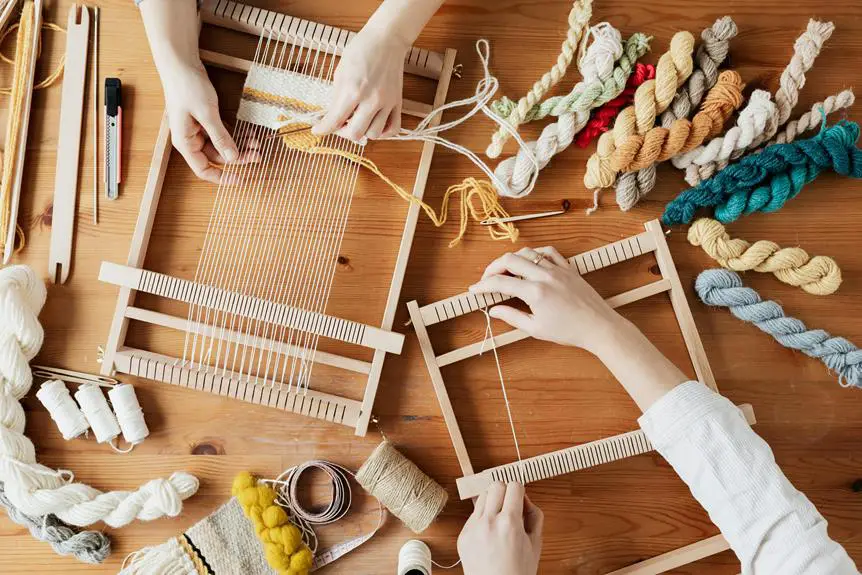So, you've caught the weaving bug and you're ready to dive into the world of looms. But which one is best for you as a beginner? With so many options out there, it can be overwhelming to choose the right one to start your weaving journey.
In this guide, we'll explore the different types of looms suitable for beginners, factors to consider when making your selection, and some budget-friendly options to get you started. Whether you're limited on space or looking for the best bang for your buck, we'll help you navigate the world of looms and find the perfect one for your weaving aspirations.
Key Takeaways
- Rigid heddle loom is user-friendly, versatile, and affordable, making it a great option for beginners.
- Tapestry weaving allows for intricate designs and images, providing a creative outlet for beginners.
- Pin loom is small, portable, and affordable, making it a convenient choice for beginners.
- When choosing a loom, factors to consider include loom size and portability, material and weaving patterns, and making an informed decision as a beginner.
Types of Looms for Beginners
When starting out with weaving, a simple rigid heddle loom is the best choice for beginners. This type of loom is user-friendly and versatile, making it ideal for those new to the craft. The rigid heddle loom is a frame loom, which means it has a simple, rectangular frame with a heddle that holds the warp threads. This design makes it easy to set up and operate, allowing you to focus on mastering the weaving techniques.
For beginners, tapestry weaving on a rigid heddle loom is an excellent way to start. This technique involves creating intricate designs and images by weaving different colored weft threads across the warp. The simple operation of the rigid heddle loom makes it easier to practice and perfect this method.
Another option for beginners is the pin loom, which is a small, portable loom that's perfect for learning the basics of weaving. It's great for creating small projects like coasters or decorative squares. The simplicity of the pin loom makes it a fantastic starting point for those new to weaving.
As you begin your weaving journey, consider starting with a rigid heddle loom or a pin loom to build a strong foundation in this timeless craft.
Factors to Consider When Choosing a Loom
When selecting a loom as a beginner, consider the size of the loom and the types of projects you want to create.
- Loom size and portability: The size of the loom is crucial. Larger looms are suitable for bigger projects such as blankets and rugs, but they require more space and can be less portable. Smaller looms are more manageable and portable, making them ideal for beginners or those with limited space. Consider where you'll be weaving and whether you need a loom that can be easily transported.
- Material and weaving patterns: Different looms are designed for specific materials and weaving patterns. Some looms are better suited for weaving with yarn, while others are designed for heavier materials like wool or cotton. Additionally, certain looms are better equipped for specific weaving patterns such as plain weave, twill, or complex patterns. Consider the type of material you want to work with and the weaving patterns you want to create when choosing a loom.
Considering these factors will help you make an informed decision when selecting a loom as a beginner.
Best Loom for Small Spaces
For small spaces, compact looms are essential for accommodating limited weaving areas and enabling easy storage. When considering looms for small spaces, portable options are key. Look for tabletop or floor looms with a small footprint that can be easily moved or stored when not in use.
Some popular portable loom options include rigid heddle looms, table looms, and some smaller frame looms. These looms are designed to be lightweight and easy to transport, making them ideal for weavers with limited space.
Additionally, space-saving weaving techniques can be employed to maximize the use of small weaving areas. Techniques such as using a warping board to create longer warps in a limited space, or utilizing a smaller reed or heddle to weave narrower pieces are great strategies for small space weaving.
When selecting a loom for a small space, prioritize functionality and ease of storage without compromising on weaving capabilities. By choosing a portable loom and implementing space-saving weaving techniques, you can enjoy weaving in even the smallest of spaces.
Budget-Friendly Loom Options
Looking for budget-friendly loom options that are ideal for small spaces? As a beginner weaver, you'll want to start honing your skills without breaking the bank. Here are three top options to consider:
- Rigid Heddle Loom: This type of loom isn't only affordable but also versatile, making it perfect for beginners. It's compact and can easily fit in small spaces. With a rigid heddle loom, you can explore various weaving techniques and create beautiful beginner projects such as scarves, table runners, and simple bags.
- Frame Loom: Frame looms are typically inexpensive and great for learning the basics of weaving. They're compact and can be used on a table or even propped up against a wall. Frame looms are excellent for experimenting with different yarn options and practicing fundamental weaving techniques.
- Pin Loom: If you're really tight on space and budget, a pin loom is an excellent choice. These small, portable looms are affordable and perfect for weaving small squares. You can easily find online tutorials for using a pin loom and create fun, quick beginner projects like coasters, patches, or even small decorative elements for larger projects.
With these budget-friendly options, you can start your weaving journey without a significant investment and begin mastering various weaving techniques while working on engaging beginner projects.
Recommended Accessories for Beginner Weavers
Wondering what essential accessories you need as a beginner weaver to enhance your weaving experience? As you embark on your weaving journey, having the right accessories can make a significant difference in the quality of your work. When it comes to yarn choices, opt for a variety of textures and colors to add depth and interest to your weavings. Experiment with different yarn weights and materials to expand your creative possibilities. Additionally, familiarizing yourself with various warping techniques will allow you to create diverse patterns and designs. Understanding the fundamentals of warping will give you a solid foundation for more complex weaving projects in the future.
Here's a table summarizing the recommended accessories for beginner weavers:
| Accessory | Description | Benefits |
|---|---|---|
| Assorted Yarn | Various textures and colors for creativity | Adds depth and interest to your weavings |
| Warping Board | Tool for precise warping | Ensures even tension and straight edges |
| Shed Stick | Facilitates shed opening for smooth weaving | Helps create clean sheds for efficient weaving |
| Tapestry Needles | Essential for finishing and weaving in ends | Perfect for securing loose ends and adding details |
| Scissors | High-quality scissors for cutting yarn | Ensures clean cuts for a polished end result |
Investing in these accessories will equip you with the tools necessary to elevate your weaving skills and broaden your creative horizons.
Frequently Asked Questions
Can I Use a Beginner Loom to Create More Advanced Weaving Patterns?
You can use a beginner loom to create more advanced weaving patterns, but you may face limitations. However, with practice and creativity, there are still plenty of creative possibilities despite the restrictions.
Are There Any Specific Maintenance or Care Tips for Beginner Looms?
To maintain your beginner loom, regularly clean it to prevent dust buildup. Check the tension and re-warp if needed. Proper maintenance ensures smooth weaving. Keep practicing, and you'll master advanced techniques in no time.
What Kind of Yarn Is Best Suited for Beginner Looms?
For beginner looms, the best yarn is a medium-weight yarn like worsted or DK. It's compatible with most looms and great for learning basic weaving techniques. Stick to smooth yarn types for easy handling and start with simple beginner projects.
Are There Any Online Communities or Forums for Beginner Weavers Using Specific Loom Types?
Looking for weaving techniques and online tutorials? Check out online communities and forums. They're great for sharing loom modifications and troubleshooting issues. You'll find a wealth of knowledge and support from experienced weavers.
Can Beginner Looms Be Easily Upgraded to Accommodate Larger or More Complex Projects as Skills Improve?
As you progress in skills, beginner looms can be upgraded for larger or more complex projects. Look for options like additional heddles or a wider reed. This allows you to weave advanced patterns and accommodate your growing expertise.
- Understanding China’s Role in Global PCB and Assembly Fabrication - June 20, 2025
- Navigating the Zhongda Fabric and Accessories Center in Guangzhou - June 20, 2025
- How to Find and Partner With Fabric Exporters in China - June 20, 2025






